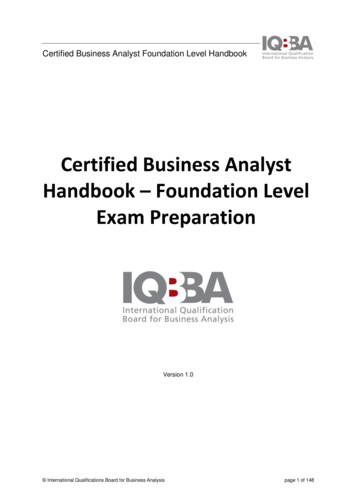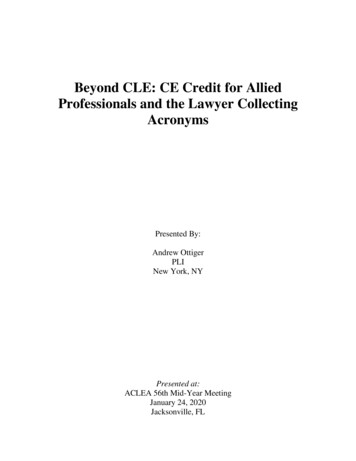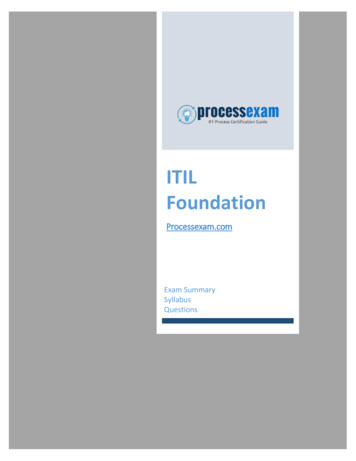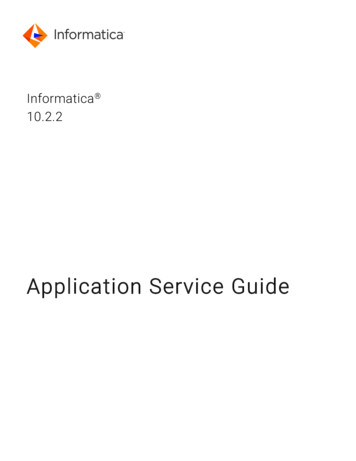
Transcription
Certified Business Analyst Foundation Level HandbookCertified Business AnalystHandbook – Foundation LevelExam PreparationVersion 1.0 International Qualifications Board for Business Analysispage 1 of 148
Certified Business Analyst Foundation Level HandbookCopyright NoticeThis document may be copied in its entirety, or extracts made, if the source is acknowledged.Copyright Notice International Qualifications Board for Business Analysis (hereinafter calledIQBBA )IQBBA is a registered trademark of GASQ Service GmbH.The authors for version 2.0, released in October 2017 hereby provide their copyright rights to IQBBAfor this 2019 versionAll rights reserved. International Qualifications Board for Business Analysispage 2 of 148
Certified Business Analyst Foundation Level HandbookTable of Contents1.Fundamentals of Business Analysis . 81.1Terms and Definitions . 81.2Role of the Business Analyst . 121.3Overview on the Business Analysis Activities . 141.4Competencies . 161.5Sample Exam Questions . 201.5.1Question 1.1 . 201.5.2Question 1.2 . 201.5.3Question 1.3 . 201.62.Strategy Definition . 222.1Introduction . 222.2Internal Analysis . 222.2.1Vision, Mission and Business Goals . 222.2.2Business Process Analysis . 242.2.3The Concept of Business Needs . 272.2.4Gap Analysis. 282.3External Analysis . 292.3.1Market Research and Analysis . 292.3.2User Needs Identification . 312.4Stakeholder Identification . 322.5Solution Proposal and Analysis . 352.6Project Initiation . 402.7Sample Exam Questions . 412.7.1Question 2.1 . 412.7.2Question 2.2 . 412.7.3Question 2.3 . 412.7.4Question 2.4 . 422.83.Answers and Justifications . 20Answers and Justifications . 43Management of Business Analysis Process . 443.1Introduction . 443.2Approaches to Business Analysis . 443.2.1Traditional vs. Agile Environments . 453.2.2Interdisciplinary Approach . 503.3Communication . 533.4Products. 57 International Qualifications Board for Business Analysispage 3 of 148
Certified Business Analyst Foundation Level Handbook3.53.5.1Tools and Techniques . 603.5.2Notations . 623.6Sample Exam Questions . 633.6.1Question 3.1 . 633.6.2Question 3.2 . 633.6.3Question 3.3 . 633.6.4Question 3.4 . 643.6.5Question 3.5 . 643.6.6Question 3.6 . 643.6.7Question 3.7 . 653.6.8Question 3.8 . 653.6.9Question 3.9 . 653.6.10Question 3.10 . 653.6.11Question 3.11 . 663.6.12Question 3.12 . 663.74.Tools and Techniques . 60Answers and Justifications . 66Requirements Engineering in Business Analysis . 704.1Requirements Development . 704.1.1Introduction . 704.1.2Elicitation . 71Questionnaire . 72Interview . 73Persona and user story . 73Use case . 74User scenario . 74Self-recording . 75Consultancy . 75Analysis of existing business documents . 75Brainstorming . 76Field observation . 78Apprenticing . 79Workshops with stakeholders . 794.1.3Analysis and Modeling . 80Requirements analysis . 80Constraints and assumptions . 83Conflict management . 83 International Qualifications Board for Business Analysispage 4 of 148
Certified Business Analyst Foundation Level HandbookModeling . 854.1.4Specification . 904.1.5Verification and Validation . 984.2Requirements Management . 1014.2.1Introduction . 1014.2.2Information Architecture . 1014.2.3Requirements Communication . 1044.2.4Traceability . 1064.2.5Configuration Management . 110Configuration Management . 110Change Management . 1124.2.6Solution Scope Management . 1144.2.7Quality Assurance . 1154.3Tools and Techniques . 1164.3.1Tools and Techniques . 116Brainstorming, Persona, User story, Use case, User scenario, Survey (questionnaire),Workshop. 116Prototyping, Decomposition, Story mapping . 1165 Whys . 1164.3.24.4Notations . 116Sample Exam Questions . 1204.4.1Question 4.1 . 1204.4.2Question 4.2 . 1204.4.3Question 4.3 . 1204.4.4Question 4.4 . 1214.4.5Question 4.5 . 1214.4.6Question 4.6 . 1214.4.7Question 4.7 . 1214.4.8Question 4.8 . 1224.4.9Question 4.9 . 1224.4.10Question 4.10 . 1234.4.11Question 4.11 . 1234.4.12Question 4.12 . 1234.4.13Question 4.13 . 1244.4.14Question 4.14 . 1244.4.15Question 4.15 . 1244.4.16Question 4.16 . 1254.4.17Question 4.17 . 125 International Qualifications Board for Business Analysispage 5 of 148
Certified Business Analyst Foundation Level Handbook4.4.184.55.Answers and Justifications . 126Solution Evaluation and Optimization . 1305.1Evaluation . 1305.2Optimization . 1335.3Sample Exam Questions . 1395.3.1Question 5.1 . 1395.3.2Question 5.2 . 1395.3.3Question 5.3 . 1405.46.Question 4.18 . 125Answers and Justifications . 140References . 1415.5Books and Other Publications . 1415.6Standards . 1437.Figures . 1448.Tables . 148 International Qualifications Board for Business Analysispage 6 of 148
Certified Business Analyst Foundation Level HandbookIntroduction to this HandbookPurpose and scopeThis handbook serves as a guideline for preparing for IQBBA certification.The document reuses the IQBBA Foundation Level Syllabus version 2019 and extends its content withexamples and sample exam questions (IQBBA FL Sample Exam Set Version 1.0, 15 November2018).Sample exam questionsExam questions presented in this document were never a part of the real examination. They werecreated for educational purposes and should be considered as a help in exam preparation. Thequestions are documented in the official IQBBA document: IQBBA FL Sample Exam Set Version 1.0,15 November 2018ExaminationThe examination to become a Certified Business Analyst is based on the IQBBA Foundation Levelsyllabus. All sections of the syllabus are subject to examination. The examination questions are notnecessarily confined to an individual section. A single question may refer to information in severalsections.The full examination areas are defined in the Learning Objectives of the syllabus. Consequently, theLearning Objectives provide the framework for the exams.The format of the examination is Multiple Choice with a single correct option (one correct answer outof four options).The exam set contains 40 questions.Examinations can be taken after having attended accredited courses, or in an open examinationwithout a previous course. You will find detailed information regarding examination times on the GASQwebsite (www.gasq.org) and on the IQBBA website (www.IQBBA.org). International Qualifications Board for Business Analysispage 7 of 148
Certified Business Analyst Foundation Level Handbook1. Fundamentals of Business Analysis1.1Terms and DefinitionsThe BABOK Guide 2.0 defined Business Analysis as the set of tasks, knowledge, tools and techniquesrequired to identify business needs and determine solutions to business problems [BABOK]. The latestversion of BABOK Guide, 3.0, updates the definition to highlight the aspect of value.Business Analysis – the practice of enabling change in an enterprise by defining needs andrecommending solutions that deliver value to stakeholders. Business Analysis enables an enterprise toarticulate needs and the rationale for change, and to design and describe solutions that can delivervalue [BABOK].Specific activities of Business Analysis are collected within knowledge areas (KA). IQBBA proposesthe following KAs: Strategy definitionManagement of Business Analysis processRequirements Engineering in Business AnalysisSolution evaluation and optimizationThese KAs are supported by specific methods, tools, and techniques, and require specific skills andcompetencies.Figure 1 Overview of Business Analysis areasThe activities of the Business Analyst may vary depending on his role and scope of responsibility. ABusiness Analyst working at the organization level is typically responsible for collecting insights andbusiness needs and/or opportunities from the business environment (customers, competitors,organization’s assets) and proposing new, often innovative, business solutions. A Business Analystworking at the program/project level will instead be in charge of delivering the agreed businesssolution – in this context the role can be compared to the Product Owner in Agile.Business Analysis tasks may differ depending on the product life cycle. During initial phases of aproduct life cycle, a Business Analyst is typically responsible for establishing business needs andproposing a solution, later – during solution development – a BA’s activities are concerned withhelping the team to build the right solution. When the product is released and working in production,typical BA tasks include monitoring and improving its efficiency, and introducing changes wherenecessary. International Qualifications Board for Business Analysispage 8 of 148
Certified Business Analyst Foundation Level HandbookSolution – the implementation of the requirement or a design idea which, if implemented, is expectedto lead to the partial or full satisfaction of a set of attribute requirements; to solve a (defined) problem[Tgilb].Sample solutions for delivering value may include: Changes to the organization culture or structureImprovements to the business processDevelopment of business products or servicesDevelopment of solutions (also software) supporting business activitiesFigure 2 Business Analysis and Requirements EngineeringSolutions are built based on requirements. A requirement can be defined as the documentedrepresentation of a need of specific stakeholders or organization, bringing a value to the business[BABOK][IEEE 610].Requirement:(1) A condition or capability needed by a user to solve a problem or achieve an objective.(2) A condition or capability that must be met or possessed by a system or system component tosatisfy a contract, standard, specification, or other formally imposed documents.(3) A documented representation of a condition or capability as in (1) or (2) [IEEE 610].Requirements are the foundation of solution scope and design. Requirements are typically classifiedinto categories to allow better management. BABOK Guide proposes the following classification,representing the abstraction levels for requirements: Business requirementsStakeholder’s requirementsTransition requirementsSolution requirementso Functional requirementso Non-functional requirementsBusiness requirement – a high level type of requirement expressing needs of the business.Functional requirement – a requirement that specifies a function that a component or system mustperform [IEEE 610].Non-functional requirement – a requirement that does not relate to functionality, but to attributessuch as reliability, efficiency, usability, maintainability and portability. International Qualifications Board for Business Analysispage 9 of 148
Certified Business Analyst Foundation Level HandbookMeaning of different types of requirementsBusiness requirements – the highest level of requirements, developed during StrategyDefinition activities. Business requirements define the high-level goals, objectives andneeds of the organization.Stakeholder requirements – elaboration of business requirements, defining the needs ofstakeholders and how they will interact with a solution.Solution requirements – the most detailed type of requirements describing the solutioncharacteristics that will be needed to meet the higher-level business and stakeholderrequirements.Functional requirements – the capabilities that a product must provide to its usersNon-functional requirements – quality attributes, design and implementation constraints andexternal interfaces that must be possessed by the productTransition requirements – the solution capabilities required to transition from the current tothe future state and are no longer needed once the transition is completeFigure 3 Levels of requirementsBusiness RequirementsWHAT the business is trying to achieveWHY a project should be undertaken or a solution implementedMetrics that will be used to measure success International Qualifications Board for Business Analysispage 10 of 148
Certified Business Analyst Foundation Level HandbookStakeholder RequirementsWHAT each specific stakeholder/group needs from a solutionUse cases of a solutionBridge between business requirements and solution requirementsSolution RequirementsWHAT characteristics the solution will supportHOW are the stakeholders’ needs are satisfiedExamplesBusiness requirementReduce errors in processing customer orders by 30% by the endof the next yearStakeholder requirementsCreate new orderView order historyCheck order statusSolution requirementsFunctional requirementsThe system should display customer order historyThe system should allow the customer to create new orderNonfunctional requirmentsThe system should support up to 300 concurrent usersThe system should be operating on Chrome xxTransition requirementsHistorical orders should be transferred to the new systemTable 1 Examples of requirementsIQBBA extends the above classification to add information supporting solution design andrequirements management: Business constraintsSolution constraintsBusiness assumptionsTechnical assumptionsConstraint – a statement of restriction that modifies a requirement or set of requirements by limitingthe range of acceptable solutions.Business constraint – the limitations on the project’s flexibility to implement the requested solution[BABOK].Solution constraint – any restrictions that are related to the design and architecture of the solutionsuch as hardware and software platforms, programming language or technology, and software thatmust be used [BABOK].Assumption – an influencing factor or condition that is believed to be true at given moment but hasnot been confirmed to be accurate. International Qualifications Board for Business Analysispage 11 of 148
Certified Business Analyst Foundation Level HandbookBusiness assumption – an assumption related to the business domain or development/maintenanceconditions.Technical assumption – an assumption related to technical aspects of the planned solution.When working with different levels of abstraction of requirements, it is important to maintain traceability(see: 4.2.4 Traceability ) supporting scope management, coverage analysis and change impactanalysis.QuestionsRecall the definition of a requirement, Business Analysis, and solutionExplain how requirements can be classifiedExplain the role of Business Analysis in an organization, program and projectProvide examples of objectives of Business Analysis in the different phases of a product life cycleRecall main knowledge areas in Business Analysis1.2Role of the Business AnalystThe Business Analyst (BA) is a person responsible for identifying business needs of stakeholders andfor determining solutions to business problems with the aim of introducing change which adds value tothe business. As mentioned in BABOK Guide, the Business Analyst is someone who “helpsorganization change”.Business Analyst – a person responsible for identifying the business needs of their clients andstakeholders, to determine solutions to business problems [BABOK].The Business Analyst often acts as a bridge between business stakeholders and the solution deliveryteam, identifying, negotiating, and achieving a consensus between the needs of the variousrepresentative individuals and groups.Figure 4 Alternative roles for a Business Analyst International Qualifications Board for Business Analysispage 12 of 148
Certified Business Analyst Foundation Level HandbookFigure 5 The role of a Business AnalystAs one of the main work products of Business Analysis are business needs and businessrequirements, BAs play an important role in the success of both organization-level programs and inspecific change or development work.Problems with requirements can cause change or development work to fail. In most cases theseproblems are caused by poor or incorrectly conducted Business Analysis (especially RequirementsEngineering, a part of the Business Analysis knowledge area).Common pitfalls in Business Analysis include but are not restricted to: Unclear business objectives of the initiativeMissing business requirements, often the result of lack of analysis of the stakeholdersInstability of the requirements (frequent and uncontrolled changes in requirements)Poor translation of the business needs to requirements (incomplete, inconsistent, or notmeasurable requirements)Communication problems and knowledge barriersThe above issues may result in problems later, such as during solution proposal scope definition,solution realization planning, implementation or testing. Unclear business requirements, or a lowquality business design of the solution, can lead to confusion and to
Business Analysis enables an enterprise to articulate needs and the rationale for change, and to design and describe solutions that can deliver value [BABOK]. Specific activities of Business Analysis are collected within knowledge areas (KA). IQBBA proposes the following KAs: Strategy definition










